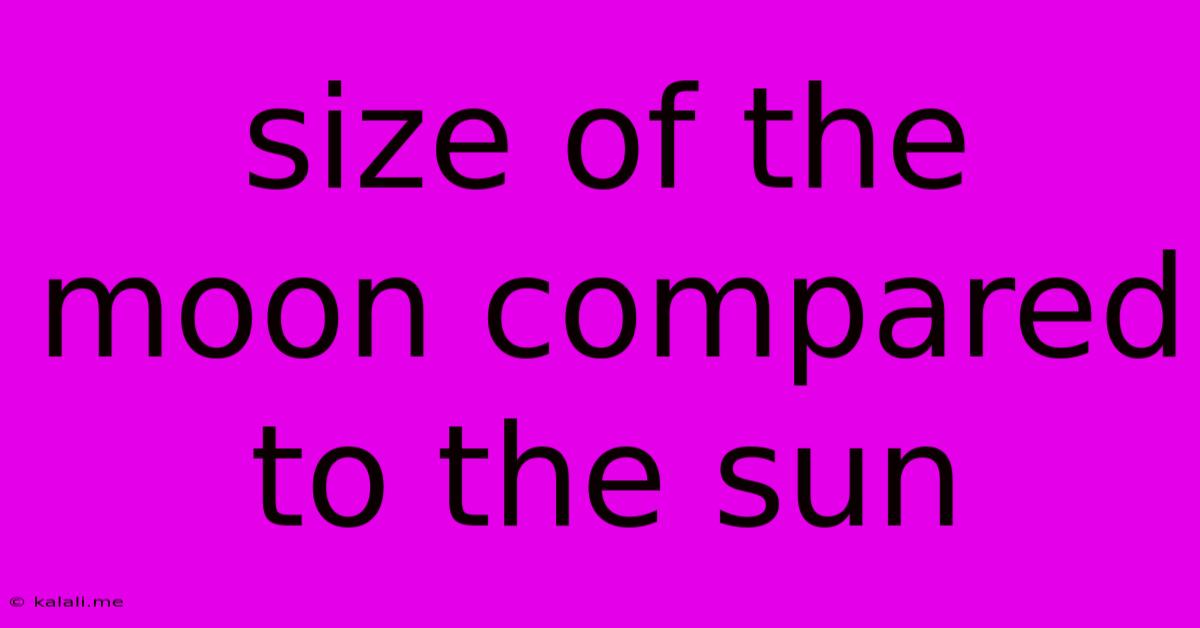Size Of The Moon Compared To The Sun
Kalali
Jun 09, 2025 · 3 min read

Table of Contents
The Moon and the Sun: A Tale of Two Celestial Bodies and Their Size Comparison
Meta Description: Discover the fascinating size difference between the Sun and the Moon, exploring their relative sizes, distances from Earth, and the impact on celestial events like eclipses. Learn about apparent size versus actual size and how this relates to our perception of these celestial giants.
The Sun and the Moon, two celestial bodies that dominate our sky, hold a captivating place in human history and mythology. While both appear roughly the same size from Earth, their actual sizes differ dramatically. Understanding this disparity is key to comprehending various astronomical phenomena, from solar and lunar eclipses to the tides. This article delves into the fascinating comparison of the Sun and Moon's sizes, exploring the science behind their apparent similarity and their actual differences.
The Sun: A Star of Immense Proportions
The Sun, our closest star, is a colossal sphere of incandescent plasma. Its sheer size dwarfs the Moon and even the Earth. The Sun's diameter is approximately 1.39 million kilometers (864,000 miles), making it about 109 times wider than Earth. Its volume could hold over 1.3 million Earths! The Sun's immense mass accounts for about 99.86% of the total mass of the entire solar system. This gravitational dominance dictates the orbits of all the planets and other celestial bodies within our solar system. Understanding its scale helps us comprehend its powerful influence on our planet.
The Moon: Earth's Faithful Companion
In comparison, the Moon, Earth's only natural satellite, is significantly smaller. Its diameter measures roughly 3,474 kilometers (2,159 miles), which is just over a quarter of Earth's diameter. While seemingly large in our night sky, the Moon is a relatively small celestial body compared to the Sun or even many other planets and moons in our solar system. However, its proximity to Earth gives it a prominent role in our planet's history and our everyday lives. From influencing tides to providing a beautiful night-time spectacle, the Moon's influence is undeniable.
Apparent Size vs. Actual Size: The Illusion of Equality
The intriguing aspect is that despite the vast difference in their actual sizes, the Sun and Moon appear to be almost the same size when viewed from Earth. This is purely a matter of perspective and distance. The Sun is incredibly large but also incredibly far away (approximately 150 million kilometers or 93 million miles). The Moon, being much smaller, is significantly closer (an average of 384,400 kilometers or 238,900 miles). This combination of size and distance creates the optical illusion that they are roughly equal in size in the sky.
The Significance of the Apparent Size: Eclipses
This seemingly coincidental similarity in apparent size has profound consequences, most notably in the occurrence of solar and lunar eclipses. A solar eclipse happens when the Moon passes between the Sun and Earth, temporarily blocking the Sun's light. The Moon's apparent size allows it to almost perfectly cover the Sun's disk during a total solar eclipse, creating a breathtaking spectacle. Conversely, a lunar eclipse occurs when Earth passes between the Sun and Moon, casting its shadow on the Moon.
Conclusion: A Cosmic Perspective
The comparison between the Sun and Moon's sizes highlights the vast scales and distances involved in astronomy. While the Moon is relatively small compared to the Sun, its proximity to Earth gives it significant influence. The apparent equality of their sizes from Earth's perspective is a testament to the remarkable coincidences that shape our celestial experiences, resulting in awe-inspiring events like eclipses. Understanding the actual sizes and the interplay of distance and perspective offers a deeper appreciation for the wonders of our solar system.
Latest Posts
Latest Posts
-
How Many Quarts Are In 15 Gallons
Jul 01, 2025
-
How Many Ounces Are In A Bag Of Flour
Jul 01, 2025
-
How Many Cubic Feet Are In A 5 Gallon Bucket
Jul 01, 2025
-
1 Lb Of Pasta Is How Many Ounces
Jul 01, 2025
-
How Many Ounces In A Pint Of Blueberries
Jul 01, 2025
Related Post
Thank you for visiting our website which covers about Size Of The Moon Compared To The Sun . We hope the information provided has been useful to you. Feel free to contact us if you have any questions or need further assistance. See you next time and don't miss to bookmark.